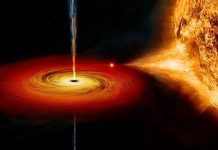
Aug. 8 (UPI) — Astronomers in the Netherlands have identified the most distant radio galaxy ever discovered.
The galaxy, TGSS J1530+1049, is located 12 billion light-years away. The record-setting radio signal hailed from a still infant universe — a time just 840 million years after the Big Bang.
Scientists at Leiden University located the galaxy using the Giant Meter-wave Radio Telescope, located in India. Hawaii’s Gemini North telescope and Arizona’s Large Binocular Telescope helped astronomers measure the galaxy’s extreme distance.
Researchers calculated the distance by measuring the galaxy’s redshift. When a galaxy is moving away from Earth, the Doppler effect causes the galaxy’s light to appear redder. The faster a galaxy is moving away from Earth, the greater its redshift. Because the farther away a galaxy is, the faster its moving away from Earth, a galaxy’s redshift serves as a proxy for measuring its distance from Earth.
Radio galaxies are giant galaxies characterized by the supermassive black holes at their centers. As these black holes pull in massive amounts of gas and dust, their accretion disks accelerate particles to high energies, yielding relativistic jets — streams of radio emissions that can be measured billions of light-years away.
That such massive galaxy existed less than a billion years after the birth of the universe is noteworthy. By characterizing the early universe’s galactic diversity and organization, scientists can better understand how galaxies form and grow, as well as more accurately model the evolution of the cosmos.
Astronomers detailed their record discovery this week in the journal Monthly Notices of the Royal Astronomical Society.
“It is very surprising how these galaxies have built up their mass in such a short period of time.” Huub Röttgering, astronomer at the Leiden Observatory, said in a news release. “Bright radio galaxies harbor supermassive black holes. It is amazing to find such objects as early in the history of the universe; the time for these supermassive black holes to form and grow must have been very short.”





